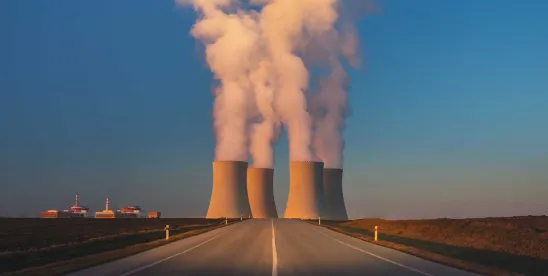On May 20, 2025, the Tennessee Valley Authority (“TVA”) announced that it is the first American utility to submit a small modular reactor (“SMR”) construction permit application (“CPA”) to the Nuclear Regulatory Commission (“NRC”). This announcement comes as a concrete response to the increased focus on adding new nuclear generation to U.S. energy resources.
As part of our ongoing series of articles regarding nuclear energy developments, the following provides a brief overview of the TVA application and recent federal and state law surrounding nuclear energy.
1. TVA Application
The TVA views its application as having broader implications beyond receipt of this individual permit. According to Don Moul, TVA President and CEO, “[t]his is a significant milestone for TVA, our region and our nation because we are accelerating the development of new nuclear technology, its supply chain and delivery model to unleash American energy…creating a path for other utilities who choose to build the same technology.”
The NRC previously approved an early site permit for the construction of SMRs at the Clinch River site in 2019, which included a certification that the site was usable for the construction of a nuclear plant from a safety, environmental and emergency planning perspective, but without identifying a specific technology. With this CPA, the TVA seeks specific approval for the construction of a GE Vernova Hitachi Nuclear Energy BWRX-300 reactor at the Clinch River site. The TVA has a targeted goal of generating nuclear energy by the 2030s. While this is the first application for approval of the BWRX-300 reactor in the U.S., GE Vernova recently announced that the BWRX-300 reactor has been approved for construction in Ontario.
Although it would not be generating energy for public consumption, chemical firm Dow, in partnership with engineering firm X-Energy, has also announced submission of a CPA to the NRC in Spring 2025, which has been accepted for review. According to the Office of Nuclear Energy’s announcement of the acceptance, the SMR would be used to power the Dow manufacturing facility in Seadrift, Texas as part of a demonstration project supported by the U.S. Department of Energy (“DOE”).
The TVA is similarly seeking strong financial support for its projects through the DOE’s Generation III+ Small Modular Reactor Program with a coalition of over a dozen other energy industry partners. This coalition is applying for the $800 million grant available through the DOE program.
2. Federal Developments
At the federal level, support for and removal of barriers to new nuclear generation has been a focal point of recent legislation and executive orders. The below provides a brief overview of key developments, which will be evaluated on an ongoing basis, including assessments of industry implications.
- Nuclear Energy Innovation and Modernization Act (“NEIMA”): Signed by President Trump in 2019, the NEIMA was intended to promote advances in nuclear power plant designs, signaling an early focus on nuclear generation. The NEIMA required the NRC to establish a staged licensing process for advanced nuclear reactors and to create a technology-inclusive regulatory framework for licensing of commercial advanced reactors. The NRC was also given two years to develop and implement strategies within the existing regulatory framework for licensing research and test reactors. In connection with each of the above, the NRC was further required to provide intermittent progress reports.
- Advance Act: Signed by President Biden in 2024, the Advance Act focuses on incentivizing competition through DOE-awarded prizes (including the grant under the Generation III+ Small Modular Reactor Program that the TVA coalition is applying for) and reducing licensing application fees, promoting microreactors through new NRC guidance and reducing cost for pre-application activities, encouraging placement of nuclear plants at retired coal plant sites, and focusing on U.S. production of high-assay low-enriched uranium.
- Executive Orders: The second Trump Administration has continued to emphasize nuclear generation through ongoing executive orders. On May 23, 2025, the Trump Administration issued four executive orders, targeting different elements of the U.S. energy sector. Our recent article discusses the implications of these executive orders.
3. State Developments
At the state level, lawmakers are using a variety of approaches to allow for and incentivize nuclear generation.
Indiana’s Senate Enrolled Act No. 424 establishes a cost recover and filing structure for SMRs. Through Colorado’s HB25-1040, nuclear power is added to the State’s definition of “clean energy resources”, which would allow nuclear projects to contribute to the State’s clean energy goals and receive local funding. This spring, the governor of Massachusetts recently announced the Energy Affordability, Independence and Innovation Act, which, among other actions, would repeal the State’s requirement for new nuclear facilities to be approved by a ballot initiative. The Wisconsin State Senate recently passed SB 125 (currently sitting with the Assembly), which would require the establishment of a nuclear sting study to identify opportunities and sites for nuclear development.
Certain states like Minnesota have outright moratoriums on the construction of new nuclear plants but their lawmakers have begun reassessing those limitations.While they did not pass, two bills were proposed this spring that would either entirely remove Minnesota’s moratorium or specifically authorize the construction of SMRs.
4. More to Come
The TVA’s application signals renewed industry interest in nuclear energy generation, and combined with legislative and executive pressures, we anticipate many more developments in this area. Stay tuned for more updates from your Foley team. Please reach out to any of the authors here or another member of your Foley team if you have any questions about these developments.






 />i
/>i
